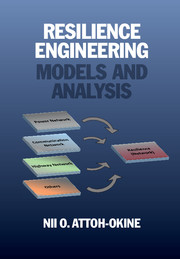Book contents
- Frontmatter
- Contents
- Preface
- Acknowledgments
- PART I INTRODUCTION
- PART II INFRASTRUCTURE SYSTEMS
- 2 Infrastructure Systems
- 3 Disruptions
- 4 Graphs and Networks
- 5 Big Data and Resilience Engineering
- 6 Graphical Models
- 7 Belief Functions
- 8 Tensors Applications
- 9 Resilience Index—Selected Examples
- 10 Epilogue
- Index
- References
6 - Graphical Models
from PART II - INFRASTRUCTURE SYSTEMS
Published online by Cambridge University Press: 05 March 2016
- Frontmatter
- Contents
- Preface
- Acknowledgments
- PART I INTRODUCTION
- PART II INFRASTRUCTURE SYSTEMS
- 2 Infrastructure Systems
- 3 Disruptions
- 4 Graphs and Networks
- 5 Big Data and Resilience Engineering
- 6 Graphical Models
- 7 Belief Functions
- 8 Tensors Applications
- 9 Resilience Index—Selected Examples
- 10 Epilogue
- Index
- References
Summary
Introduction
Graphical models are the combination of graph theory, probability theory, and decision theory. They are referred to by different names depending on the application: influence diagrams, Bayesian networks, decision networks, valuation networks, factor graphs, or Markov random fields. This chapter discusses a few of the models that are applicable to data analysis of large-scale infrastructures and hence resilience modeling and inferences. The graphical models are also compact depictions of independence and factorization assumptions of probability density functions (Chai et al. 2011). Graphical models can be directed graphs or undirected graphs. For example, Bayesian networks are directed and acyclic, whereas factor graphs are undirected. Bilmes (2010) presented a general overview of dynamic graphical models. Most of the basic graphical networks discussed in the literature are what are termed static graphical models. The static models compute probabilistic quantities of interest, either exactly or approximately based on the knowledge of the graph structure and set of Markov properties. In the dynamic model, the graph network is partitioned into various sections, and each section of the graph has its own connectivity rules. Graphical models have several properties that make them applicable to various problems where information, even limited, is available. The following are some of the properties:
• They present a method to visualize the structure of the probabilistic model that can be used to design, motivate and in some cases control new models (Bishop 2006).
• They also provide insights into the properties of a model.
• They provide simple mathematical expressions and graphical manipulations of complex problems.
Information required for resilience engineering models and analysis can be represented as shown in Table 6.1.
Pouly (2011) shows how algebraic structure can unify both the information and the inference. The algebraic structure developed can be analyzed effectively using graphical models.
Important Concepts
The section is based heavily on Castillo et al. (1997) and Lauritzen (1996) and presents a more elaborate concept in graph theory applicable to graphical models. A graph G = (V,E), where V is the finite vertices and E is the set of edges.
Information
- Type
- Chapter
- Information
- Resilience EngineeringModels and Analysis, pp. 94 - 113Publisher: Cambridge University PressPrint publication year: 2016
